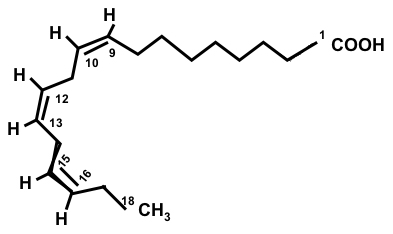April 27th, 2008 · Comments Off on So What? Oil Painting and History ·
Introduction The History Tempera Paints vs. Oil Paints Drying Oils The Extraction of Linseed Oil Linolenic Acid So What? Oil Painting and History Bibliography
Clearly, the shift from tempera paints to oil paints has had a large impact on the history of art. It has not only had an impact, however, on art history. Rather, this movement is a part of a much broader and more general movement in history, the Renaissance. The acceptance and widespread use of oil paints is crucial in this period because it embodies the changes which were occurring at this time. It is difficult to look at the Renaissance without looking at the drastic changes which were occurring in the field of art. The Renaissance encompassed a move towards realism; the use of oil paints was one of the tools used by artists during this period to represent their subjects more realistically than was possible with tempera paints.
Categories: Alpha-linolenic Acid (Linseed Oil)
Tags: Elizabeth Schroll —
April 27th, 2008 · 2 Comments ·
Categories: Chocolate (Theobromine)
Tags: Sarah Hutson —
April 27th, 2008 · Comments Off on Linolenic Acid ·
Introduction The History Tempera Paints vs. Oil Paints Drying Oils The Extraction of Linseed Oil Linolenic Acid So What? Oil Painting and History Bibliography
- Linolenic acid is a polyunsaturated fatty acid which has three double oxygen bonds
- Linolenic acid is an important component of linseed oil because of its ability to link with oxygen molecules in the air, which occurs because the molecule is unsaturated
- Oxygen is clearly necessary to the drying process, light also advances the process
Categories: Alpha-linolenic Acid (Linseed Oil)
Tags: Elizabeth Schroll —
April 27th, 2008 · Comments Off on The Extraction of Linseed Oil ·
Introduction The History Tempera Paints vs. Oil Paints Drying Oils The Extraction of Linseed Oil Linolenic Acid So What? Oil Painting and History Bibliography
- Linseed oil is pressed from the seeds of the flax plant, Linum usitatissum, which is grown in temperate and cold climates such as Argentina, India, Canada, Russia,. Morocco, China, and the British Isles
- Hot-pressed linseed oil: use of extreme heat and pressure to extract the oil from the flax seeds
- Cold-pressed linseed oil: less pressure and heat used than in the hot-pressing technique; less oil is produced but the oil produced is of a higher quality
- Refining Process: after the oil is extracted, there are still impurities; the oil is mixed together with sulfuric acid and water to remove most of the impurities and improves color
- Other types of refined linseed oil: Varnish linseed oil, Stand oil, Bodied oil, Sun-refined oil
Categories: Alpha-linolenic Acid (Linseed Oil)
Tags: Elizabeth Schroll —
April 27th, 2008 · Comments Off on Drying Oils ·
Introduction The History Tempera Paints vs. Oil Paints Drying Oils The Extraction of Linseed Oil Linolenic Acid So What? Oil Painting and History Bibliography
- Oils: mixtures of triglycerides or fatty acids; are long chains of carboxylic acids, and may or may not contain double bonds
- Drying oils contain high proportions of unsaturated acids, like linoleic or linolenic acids
- Linseed oil has a larger percentage of linolenic acid than almost any other drying oil, which is why linseed oil is the primary drying oil used for oil painting
- As linseed oil absorbs oxygen, its density increases and larger molecules are formed through the process of polymerization
- After the drying process, the oil is in its solid form, known as linoxyn
- Sometimes siccatives or driers are added to the oils in order to speed up the drying process
Alpha-Linolenic Acid

(www.thepaleodiet.com/nutritional_tools/fats.shtml)
Categories: Alpha-linolenic Acid (Linseed Oil)
Tags: Elizabeth Schroll —
April 27th, 2008 · 3 Comments ·
Introduction The History Tempera Paints vs. Oil Paints Drying Oils The Extraction of Linseed Oil Linolenic Acid So What? Oil Painting and History Bibliography
Egg tempera paints were the primary painting medium prior to the widespread use of oil paints. In the fifteenth and sixteenth centuries, there was a gradual movement from tempera paints to oil paints as the primary medium. This movement began in northern Europe.
- Egg tempera paints: dried quickly, less color saturation, and low transparency
- Oil paints: dried more slowly (easier to work with), greater color saturation, and increased transparency

Fra Angelico, Annunciation, 1450
This painting is an example of the egg tempera medium.

Jan Van Eyck, The Marriage of Arnolfini, 1434
This painting is an example of oil painting.
Categories: Alpha-linolenic Acid (Linseed Oil)
Tags: Elizabeth Schroll —
April 27th, 2008 · Comments Off on The History ·
Introduction The History Tempera Paints vs. Oil Paints Drying Oils The Extraction of Linseed Oil Linolenic Acid So What? Oil Painting and History Bibliography
Although the invention of linseed oil as a painting medium is attributed to Jan Van Eyck in the fifteenth century, the use of drying oils have an earlier and more gradual development in the history of art.
- Galen (131-230 CE): mentions nut, hempseed, and linseed oils as drying oils
- Actius of Amida (in Mesopotamia), a physician in 540 CE, notes the importance of drying oils to painters
- Theophilus (11th/ 12th Centuries) states the value of linseed, olive, walnut, and poppy-seed oil in painting and varnishes; he did not know how to purify or refine the oils or how to speed up the drying process
- The writings of Eraclius and Petrus of St. Audemar in the 12th and 13th Centuries mention methods for the extraction and refining of the oils
- Drying oils as protective agents and as painting mediums are used in England, France and Germany in the 13th and 14th Centuries; in Italy, tempera paints still remain as the primary painting medium
- The paintings of van Eyck (15th Century) are said to have convinced the Italian painters of the merits of oil painting
- In the 16th Century, oil painting became widespread; in the 17th Century, it has become the universal medium
- Oil painting continues to remain popular to the present day
Categories: Alpha-linolenic Acid (Linseed Oil)
Tags: Elizabeth Schroll —
April 27th, 2008 · 3 Comments ·
Introduction The History Tempera Paints vs. Oil Paints Drying Oils The Extraction of Linseed Oil Linolenic Acid So What? Oil Painting and History Bibliography
Alpha-linolenic acid has received a large amount of attention in the scientific community in recent years for its role as an Omega-3 fatty acid, which is important because of the health benefits it provides. Alpha-linolenic acid and its role as one of the primary components of linseed oil, however, has also played a much different role in history. For hundreds of years, linseed oil has been used as the primary base for oil paints; the alpha-linolenic acid which is found in linseed oil is necessary in its use in painting. This site will discuss the history of oil paints, the chemistry of alpha-linolenic acid as it relates to linseed oil and oil painting, and the consequences that the shift to oil paints had on broader historical movements.
Categories: Alpha-linolenic Acid (Linseed Oil)
Tags: Elizabeth Schroll —
April 27th, 2008 · Comments Off on Chocolate affects History: Economics ·
Introduction Chemical Composition History affects Chocolate: Spread and Innovation Chocolate Affects History: Economics Chocolate Affects History: Health Benefits Chocolate Affects History: Pop Culture
Chocolate is a huge trade commodity. The average American consumer consumes approximately 25 pounds of candy (including chocolate) each year and adult consume more than kids. 50 million people around the world depend on chocolate for their livelihood according to the World Cocoa Foundation. Cacao cultivation has also caused colonization and slavery and exploitation throughout Latin America and Africa. Some human rights groups say that the exportation of cacao still has many negative effects on third world countries. For example, two thirds of cocoa production today is in West Africa, with approximately 43% coming from Cote d’Ivoire. Human rights organizations claim that up to 90% of the cultivation in West Africa is done by slave labor.
Consumers can buy Fair Trade chocolate which is certified to guaruntee that it was produced without slave labor and a fair sale price was given to the people who produced it.

Categories: Chocolate (Theobromine)
Tags: Sarah Hutson —
April 27th, 2008 · 3 Comments ·
Introduction Chemical Composition History affects Chocolate: Spread and Innovation Chocolate Affects History: Economics Chocolate Affects History: Health Benefits Chocolate Affects History: Pop Culture
The history of chocolate begins in Central America where the cocoa bean originates. It was first written about by the Mayas in 500 A.D. It was prepared mixed with chiles, vanilla and pimento as a drink called xocoatl for royalty in the Aztec culture: Montezuma allegedly drank it up to 50 times a day.

Chocolate would probably not have spread past Central America if Cortez and his conquistadores hadn’t brought it back to Spain after their conquest of Tenochtitlan. Later it was mixed with sugar instead of chiles and its popularity exploded in Europe. Cacao is now cultivated as a cash crop in many different regions of the world including Central and South America and most of all, Western Africa.
The high demand for chocolate led to innovations in the 1800’s. Dutchman Coenraad Johannes van Houten made cocoa powder and cocoa butter in 1828. The Cadbury brothers made one of the first eatable chocolates in 1849. David Peter, a Swiss candle maker, invented milk chocolate in 1867 with the help of his neighbor, a baby-food manufacturer Henri Nestle. To this day, chocolate quality and innovation is associated with these names and nationalities. More chocolate innovations were caused by the competition between the two leading American chocolate companies, Hershey and Mars.


Categories: Chocolate (Theobromine)
Tags: Sarah Hutson —









